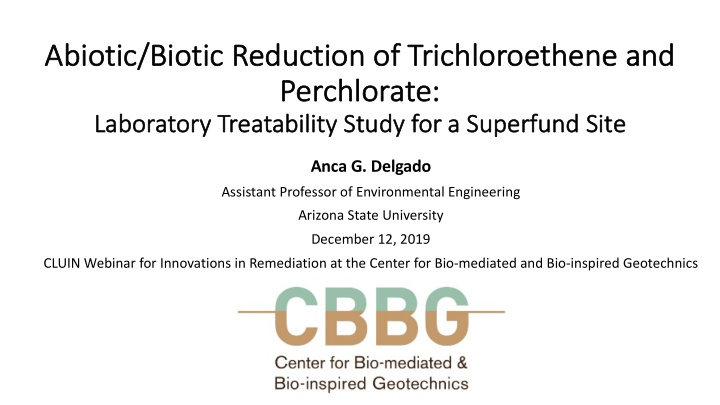



Ab Abiotic/Bi Biotic Reduction of Trichloroethene and Pe Perchlorate: Laboratory y Treatability y Study y for a Superfund Site Anca G. Delgado Assistant Professor of Environmental Engineering Arizona State University December 12, 2019 CLUIN Webinar for Innovations in Remediation at the Center for Bio-mediated and Bio-inspired Geotechnics
Phoenix-Goodyear Airport North (PGA-N) Superfund Site, Goodyear, AZ - Added to the NPL in 1983 - Groundwater impacted by trichloroethene (TCE) and perchlorate - Chromium, cadmium, aluminum, and copper in certain source area soils - Subunit A - Interbedded sands, silty sands, and clayey sands with localized sand and gravel sequences; groundwater depth 90-140 feet bgs; groundwater flow direction north- northwesterly 2
Proposed source area remediation Photo courtesy of Catherine Brown, EPA - Five groundwater pump and treat systems returning cleaned water using reinjection, infiltration and irrigation. - In situ chemical reduction has been employed on a limited scale. - Treatability Study: develop design-related insights for a potential remedy for Subunit A source area groundwater (approved by the EPA and contained in the Record of Decision Amendment Sep 2014). 3
Combined remedy using zero-valent iron and microbial reductive dechlorination 4
Semi-batch microcosm study – TCE reduction Mi Microcosms – 25 25 g soil and 75 75 mL L groundwater High ZVI: 15 g L −1 mZVI & 1.5 g L −1 nZVI • Low ZVI: 2.5 mL spent ZVI from High ZVI • microcosms Fe (II)” 0.25 g L −1 • 560 mg/L lactate and 170 mg/L emulsified • vegetable oil (biostim) SDC-9 and ZARA-10: Dehalococcoides • mccartyi bioaugmentation cultures Mohana Rangan et al. (in prep.) 5
Semi-batch microcosm study – Perchlorate reduction Mohana Rangan et al. (in prep.) # = non-detect 6 SDC-9 and ZARA-10: Dehalococcoides mccartyi bioaugmentation cultures
Growth of Dehalococcoides mccartyi in the presence of ZVI and Fe (II) Mohana Rangan et al. (in prep.) 7
Microbial communities enriched in microcosms Mi Microcosms – 25 25 g soil and 75 75 mL L groundwater High ZVI: 15 g L −1 mZVI & 1.5 g L −1 nZVI • Low ZVI: 2.5 mL spent ZVI from High ZVI • microcosms Fe (II)” 0.25 g L −1 • • 560 mg/L lactate and 170 mg/L emulsified vegetable oil (biostim) • SDC-9 and ZARA-10: Dehalococcoides mccartyi bioaugmentation cultures 8 Mohana Rangan et al. (in prep.)
Lessons learned from treatability study i. Abiotic TCE reduction to ethene and ethane was highly effective at high ZVI concentrations. ii. Microbial perchlorate reduction was partially inhibited at high ZVI and Fe (II) concentrations. iii. Microbial TCE reductive dechlorination was a significant process at low but not high ZVI concentrations iv. Synergy between abiotic and biotic reduction processes was observed under flow- through conditions. v. Biostimulation/bioaugmentation (no ZVI) achieved similar outcomes in terms of complete TCE dechlorination to ethene. 9
Delgado Lab Krajmalnik-Brown Lab Delgado Lab Krajmalnik-Brown Lab Project team : Srivatsan Mohana Rangan, M.S. Shefali Rao, M.S. Aatikah Mouti, B.S. Gregory Lowry (collaborator) Harry Brenton Laurie LaPat-Polasko Anca G. Delgado (co-PI) Rosa Krajmalnik-Brown (PI) 10
Tha Thank nk y you! u! an anca. a.delg lgad ado@as o@asu.edu delgadolab.org 11
Recommend
More recommend